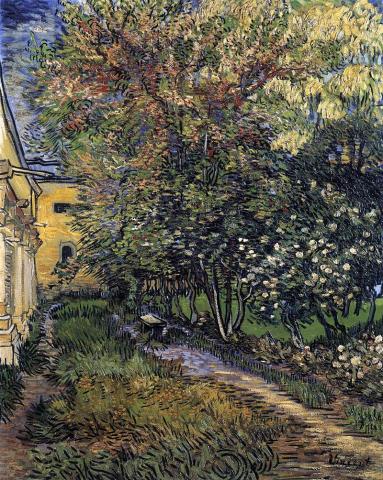-
Table of Contents
- 0. STORY PREFACE
- 1. EARLY LIFE
- 2. AN ARTIST IS BORN
- 3. STUDYING ART, FEELING PAIN
- 4. THE FIRST MASTERPIECE
- 5. THE PARIS YEARS
- 6. INFLUENCE of JAPANESE ART
- 7. EARLY LIFE in ARLES
- 8. THE BANDAGED EAR
- 9. VINCENT at SAINT-REMY
- 10. THE ATTACKS CONTINUE
- 11. PAINTING in AUVERS-sur-OISE
- 12. WORRIES and TURMOIL
- 13. VINCENT COMMITS SUICIDE
- 14. THE SADNESS WILL LAST FOREVER
After Vincent checked into Saint-Paul Hospital in Saint-Rémy, he continued to paint. This oil-on-canvas, which measures 95 x 76 cm, depicts “The Garden of Saint-Paul Hospital.” Vincent created it during May of 1889. Today it is owned by the Rijksmuseum Kröller-Müller, in Otterlo. Click on the image for a better view.
When Vincent checked into Saint-Paul Hospital in Saint-Rémy, he did not know what was causing his problems. Working without a previous diagnosis, his current doctor - Théophile Zacharie Auguste Peyron - believed van Gogh had a form of epilepsy. Today, scholars who have studied his condition tend to agree.
Soon after becoming a patient at Saint-Paul, van Gogh began to paint his surroundings: the hospital's garden, an iris, lilacs, a field of poppies, the mountainous landscape behind the hospital, cypress trees, an olive grove, a wheat field and - famously - a group of irises. He also described what it felt like when he had an attack:
Again - speaking of my condition - I am so grateful for yet another thing. I've noticed that others, too, hear sounds and strange voices during their attacks, as I did, and that things seemed to change before their very eyes. And that lessened the horror with which I remembered my first attack, something that, when it comes upon you unexpectedly, cannot but frighten you terribly.
Once you know it is part of the illness, you accept it like anything else ... For the suffering and the anguish are not funny when you are having an attack. (May 22, 1889 letter to Theo.)
Vincent's care-givers allowed him to paint when his condition was stable. Within a month after his arrival, he painted Starry Night - his most famous work. But even when things seemed stable, attacks would occur.
By mid-July of 1889 - soon after he painted a mountainous cottage scene - Vincent tried to swallow his own paints. When they were taken from him, he was beside himself since his art was the only thing which helped him stay reasonably calm.
-
Table of Contents
- 0. STORY PREFACE
- 1. EARLY LIFE
- 2. AN ARTIST IS BORN
- 3. STUDYING ART, FEELING PAIN
- 4. THE FIRST MASTERPIECE
- 5. THE PARIS YEARS
- 6. INFLUENCE of JAPANESE ART
- 7. EARLY LIFE in ARLES
- 8. THE BANDAGED EAR
- 9. VINCENT at SAINT-REMY
- 10. THE ATTACKS CONTINUE
- 11. PAINTING in AUVERS-sur-OISE
- 12. WORRIES and TURMOIL
- 13. VINCENT COMMITS SUICIDE
- 14. THE SADNESS WILL LAST FOREVER


 Back
Back
 Next Chapter
Next Chapter

 Back
Back
 Next Chapter
Next Chapter
